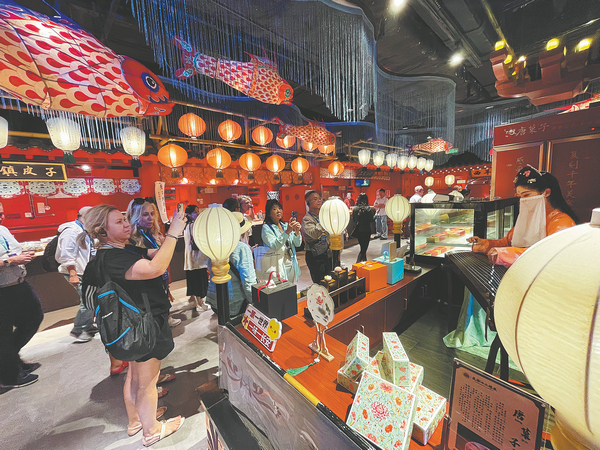 A US tour operator takes photos with Chinese performers wearing ancient folk costumes at the Twelve Hours of Chang'an theme block that vividly reproduces urban life in the Tang Dynasty (618-907), this month. YANG FEIYUE/CHINA DAILY
A US tour operator takes photos with Chinese performers wearing ancient folk costumes at the Twelve Hours of Chang'an theme block that vividly reproduces urban life in the Tang Dynasty (618-907), this month. YANG FEIYUE/CHINA DAILY
Officials and players look to in-depth discussions and exchanges to boost sector's recovery, Yang Feiyue reports in Xi'an.
At a recent forum focusing on the current and future bilateral tourism development between China and the United States, Fred Dixon, president and CEO of New York City Tourism and Conventions, highlighted significant shifts over the past year. Dixon noted a growing trend among Chinese travelers for more immersive experiences, opting for fewer destinations and longer stays.
Dixon says he has also noticed a growth in experience among Chinese travelers, who are "younger" and "more educated".
"We see nothing but tremendous opportunities and we look forward to having China back as it was before the pandemic," Dixon says.
He says tour operators in the US have seen the power of China's golden weeks and holiday periods and are working on moving some of that demand into the slower periods of the year in New York, with the launch of such programs as Broadway Week.
A total of 386,000 Chinese travelers visited New York City last year, about 35 percent of the number in 2019, before the pandemic, when the city welcomed 1.1 million Chinese travelers, Dixon says.
This year, he expects over 800,000 Chinese tourists to visit the Big Apple.
"We are delighted to be more fully engaging with our colleagues here in China," says Dixon.
Officials and players in the tourism sector gathered to discuss its potential between China and the US at the recent 14th China-US Tourism Leadership Summit in Xi'an, Northwest China's Shaanxi province.
About 400 industry representatives participated in the event to boost bilateral tourism cooperation and people-to-people exchanges between the world's two biggest economies.
They concurred that the global pandemic has had a significant impact on tourism over the past few years. But over the past year, the global tourism industry has been rapidly recovering and developing thanks to the joint efforts of government agencies and businesses around the world.
"According to our latest forecast, we anticipate that Chinese visits to the US will increase 150 percent from 2023 to 2025. That's 4.7 times faster than the rise in overall overseas visits to the US during this period," said Grant Harris, assistant secretary for industry and analysis of the US Department of Commerce, at the summit co-hosted by the Ministry of Culture and Tourism of China, the Shaanxi government, the US Department of Commerce and the US destination marketing organization Brand USA on May 22.
The US tourism players expressed anticipation for the full return of Chinese visitors to the country.
Elliott Ferguson, president and CEO of Destination DC, Washington DC's official destination marketing organization, says he and his colleagues in many US cities recognize that, among source countries of inbound visitors, travelers from China spend the most and stay the longest.
"We're always intrigued and interested in the dialogues and opportunities to see more Chinese visitors," he says.
The Washington DC side has developed a program where it interfaces with hotels, restaurants and all service providers in the city to understand the cultural differences and expectations of Chinese travelers.
"Something as easy or simple as slippers in your bedroom or tea offerings in your room makes a big difference and helps you feel at home," Ferguson says.
 Visitors from home and abroad attend a traditional music performance at the theme block. YANG FEIYUE/CHINA DAILY
Visitors from home and abroad attend a traditional music performance at the theme block. YANG FEIYUE/CHINA DAILY
He believes it's equally important for Chinese visitors to experience how the Chinese are represented in US culture and local communities and learn about the city's history and diverse cultures and cuisines. "We're putting a lot of emphasis on China simply because of the economic side of this destination and the relationships we have. Washington has about 180 embassies and the Chinese embassy is one of the largest," he says, adding that his team tries to capitalize on its resources to welcome the Chinese market and educate the American market about Chinese culture.
At the summit, Chinese tour operators also showed their endeavors to customize experiences for US travelers.
Zhou Xiaoguang, president of China Odyssey Tours, says that although the number of US travelers to China this year through the company is expected to reach about 40 percent that of 2019 due to limited flight capacity, the number of returning US travelers has significantly increased.
"We speculate that this is primarily because these guests are more interested in China, and some hold 10-year Chinese tourist visas," he says.
Zhou points out that more cost-effective tour options have been developed to meet the needs of price-sensitive US customers following the pandemic.
For high-end travelers who seek exceptional travel experiences, more unique and experiential products will be offered, he adds.
Given that many US travelers might transit through a third country before coming to China, for example, via Seoul or Tokyo, Zhou says his company will develop some travel products that include China's neighboring countries to meet the needs of American guests before entering China.
Kevin Yeung Yun-hung, secretary for Culture, Sports and Tourism of the Hong Kong Special Administrative Region government, says since the cross-border tourism industry resumed in February last year, about 800,000 American travelers have visited Hong Kong. In 2023, the city received a total of 36 million tourist visits.
A center for cultural, artistic and educational exchanges between China and the world, Hong Kong's rich Chinese culture has been highly attractive to international visitors, Yeung notes, adding that the city will leverage local characteristics to attract more overseas tourists.
Additionally, to give overseas tourists a sense of familiarity with Hong Kong, the city has actively introduced foreign brands, such as Disneyland, he says. In terms of an international and trendy culture, Hong Kong attracts major international events and brands, such as Art Basel Hong Kong and the American pop culture event ComplexCon.
The city has leveraged these culturally rich tourism products to draw international tourists, he says.
Sun Bowen, executive secretary-general of Trip.com Group's research institute, says inbound travel orders via the online travel agency, a major tourism platform in China, quadrupled in the first three months over the same period last year.
"Focusing on China-US tourism, we see that many places in China intrigue American visitors," Sun says.
Among the American travelers coming to China, those born in the 1980s and '90s make up about half and their main destinations include major cities like Shanghai, Beijing, Guangdong province's Guangzhou and Shenzhen, Sichuan province's Chengdu, Jiangsu province's Nanjing, and Zhejiang province's Hangzhou, he says. The top attractions for these visitors include Shanghai Disneyland, Universal Beijing Resort, the Terracotta Warriors in Xi'an and the Chengdu Research Base of Giant Panda Breeding.
For Chinese tourists traveling to the US, the main demographic consists of those born in the 1970s and '80s. "They typically visit major cities such as Los Angeles and San Francisco in California, New York, Boston in Massachusetts and Orlando, Florida," Sun says.
Overall, Trip.com reports that the recovery of inbound tourism from the US has reached about 60 percent of the levels seen in 2019. There is still room for growth, especially as flight routes expand, he says.
To make things easier for inbound travelers, Trip.com has partnered with the Emperor Qinshihuang's Mausoleum Site Museum in Xi'an to establish an integrated service platform that enables international visitors to purchase tickets directly onsite through an international ticketing system.
Sun proposes similar cooperation with other domestic destinations to help inbound travelers make tour appointments and payments.
Liu Shijun, vice-chairman of the World Tourism Alliance, says it is precisely because there are still various issues in China-US tourism development that relevant authorities and industry representatives of both countries should engage in candid discussions and in-depth exchanges.
"This will help both sides face and resolve the issues together …for the future of both countries, paving the way for a smoother path ahead," Liu says.
Contact the writer at yangfeiyue@chinadaily.com.cn





